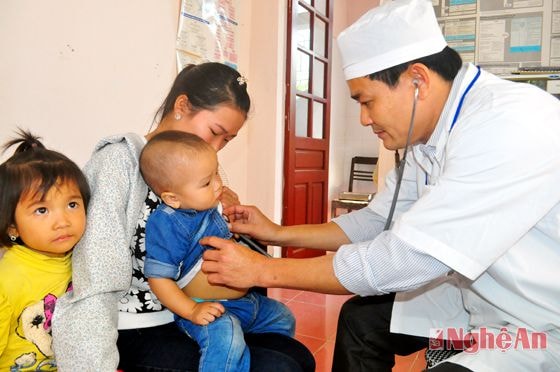Prioritize maternal and child health care
(Baonghean) - Maternal and child health care is a top priority in the work of protecting, caring for, and improving people's health.
In our province, in previous years, due to the characteristics of a large population, complex terrain conditions, underdeveloped transportation network, long distances to medical facilities; low educational level, backward customs and practices, etc., in many regions, the care and attention still faced many difficulties. In addition, the network system providing reproductive health services has been formed and consolidated, but the facilities and equipment for obstetrics and pediatrics in many district-level hospitals are still lacking, not meeting the needs of emergency care and treatment for pregnant women, children and newborns.
 |
| Health check-up for children at Dien Doai Commune Health Station (Dien Chau). |
Identifying the above limitations, in recent years, under the attention of the province, the Center for Reproductive Health Care has had many activities to support the grassroots level in maternal health care and prevention of malnutrition in children. Thereby, it has regularly organized training courses to update knowledge and improve practical capacity for medical staff at all levels in obstetric emergency resuscitation and neonatal emergency resuscitation. Each year, it organizes 10-15 classes for medical staff working in obstetrics at all levels, especially the team of midwives in mountainous, remote and isolated areas. In addition, the unit also goes directly to localities to both propagate and "hold hands to guide" to help grassroots staff become more and more professional. Providing documents and medical equipment on reproductive health care and family planning. The most obvious effect is that up to now, 100% of commune health stations have been able to deliver babies and provide emergency obstetrics and gynecology care. In the past 2 years, the number of pregnant women who delivered babies at health facilities has reached 70% and 98% of cases have been cared for by medical staff (including village health workers) during pregnancy and have been fully vaccinated. Each year, the rate of obstetric and gynecological complications has been reduced by 5%, the maternal mortality rate has decreased from 70/100,000 live births (in 2012) to 40/100,000 (in 2014).
Regarding the reduction of malnutrition rates in children, after a period of promoting communication activities, organizing classes on how to be a father, how to be a mother, and nutrition practice classes for pregnant mothers and mothers with children under 2 years old, the work of preventing and combating malnutrition in children under 5 years old from 2011 to present has been improved. Thereby, 80% of pregnant mothers and 90% of mothers with children under 2 years old have participated in nutrition practice classes; 90% of mothers with children under 2 years old have participated in nutrition practice; 95% of children under 5 years old have been monitored, weighed and measured to assess the malnutrition rate for the district and commune.
Over 90% of children are supplemented with high doses of Vitamin A, all types of vaccines are fully vaccinated for children of the right age, the school milk program is received and implemented, and preschool students are given milk. In addition to the health sector, mass organizations also actively participate in this work. In particular, the Provincial Women's Union, through the Project "5 million mothers raising good children", has implemented many forms of improving parenting skills for mothers such as health care for pregnant mothers, breastfeeding and instructions on how to supplement food properly for children.
 |
| Propaganda on population work for people in Hoa Nam block (Hoa Binh town - Tuong Duong) |
Regarding preschool level, in the past 2 years, the Education sector has implemented the topic "Improving the quality of meals for children in preschools". Thanks to that, the number of schools organizing boarding for students has increased to 99.8% (523/524), the number of schools with kitchens granted a Certificate of meeting food hygiene and safety standards has reached 93.1%. Children are guaranteed safety and no food poisoning occurs, 100% of schools use Nutrikis software to manage and calculate food portions for children, so the diet is adjusted to suit the health needs of children as well as practicality, without loss.
The quality of child care and education has been improved, children have regular eating and sleeping habits, self-service skills, civilized eating behavior, healthy, agile and confident in activities. Thereby, contributing to reducing the rate of underweight malnourished children to below 7% (less than half of the average level of the whole province).
To pay more attention to maternal and child care, relevant sectors and units need to give priority to this work; increase investment from local budgets through regular expenditure sources, investment capital, and national target programs to focus on implementing the goals of reducing maternal and neonatal mortality; research, develop and promulgate policies to attract medical staff, especially obstetricians and pediatricians to work in disadvantaged areas; regularly organize training courses to update knowledge and improve practical capacity for medical staff at all levels on obstetric emergency resuscitation and neonatal emergency resuscitation; Strengthening information - communication - health education activities to improve knowledge, change attitudes and behaviors of people, especially people in mountainous areas, remote areas, about pregnancy care, the risks of not having regular pregnancy check-ups and not giving birth at medical facilities or giving birth by themselves, giving birth without the help of trained medical staff as well as the risks of giving birth close together, giving birth to many children, giving birth early (under 20 years old) or giving birth late (over 35 years old)
My Ha






